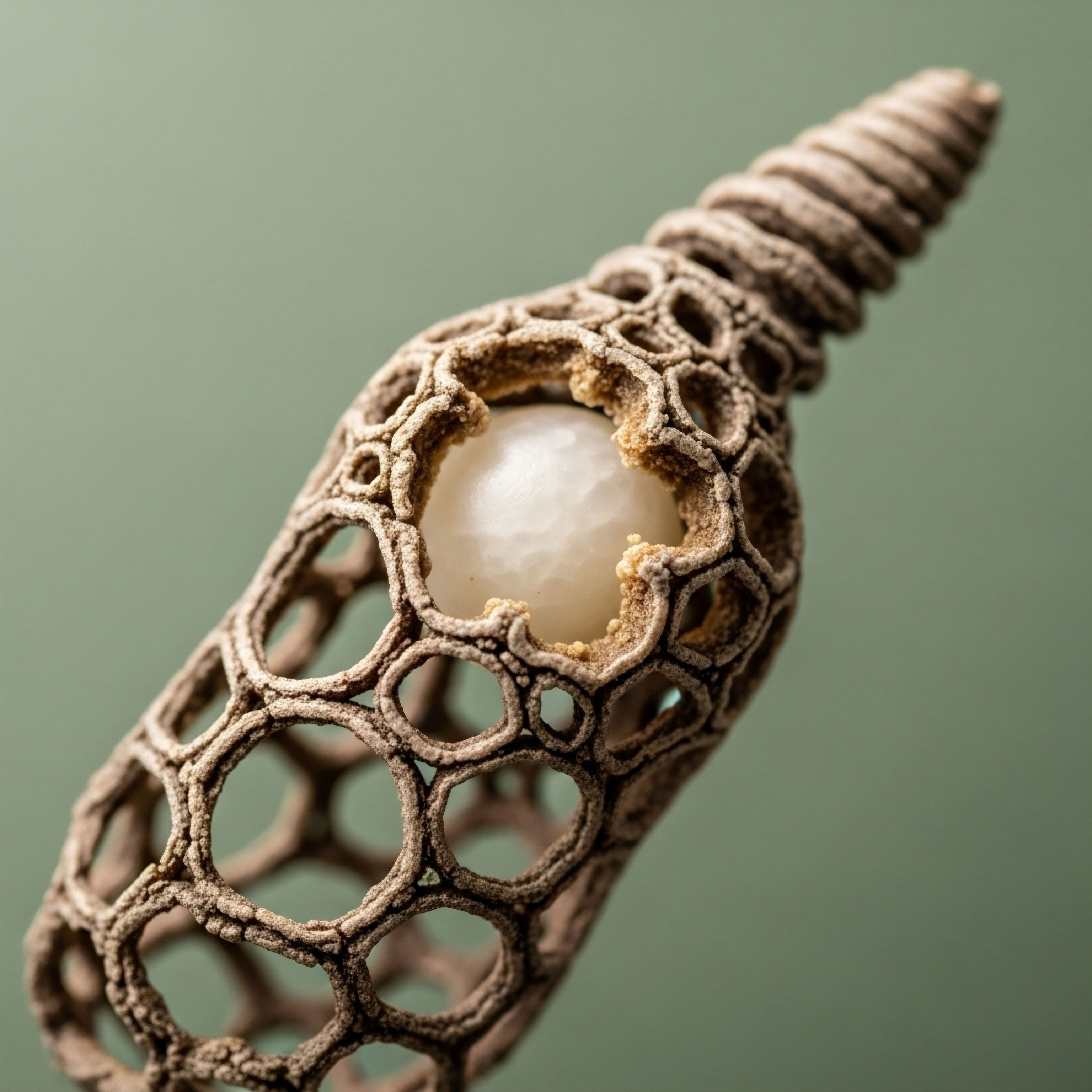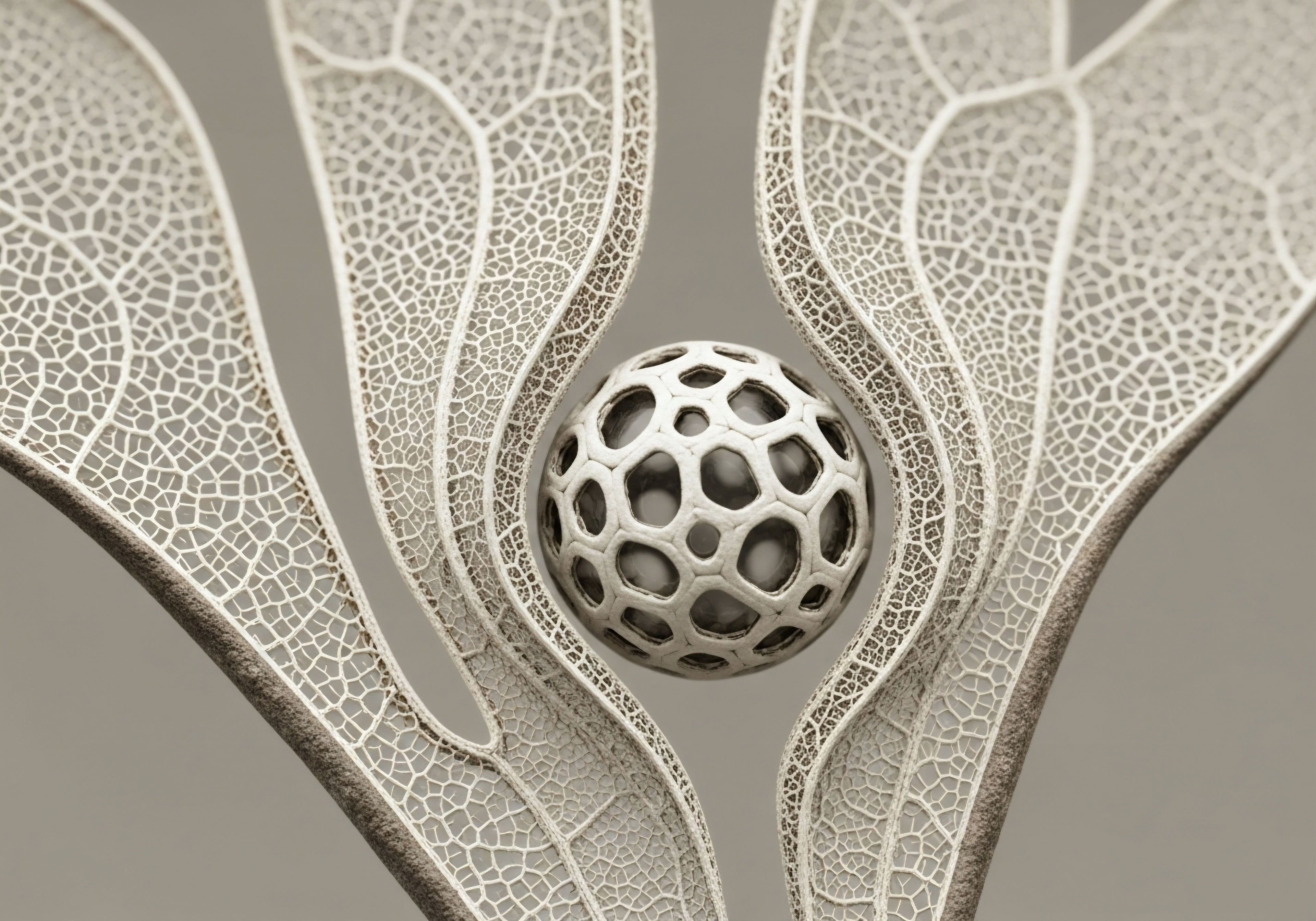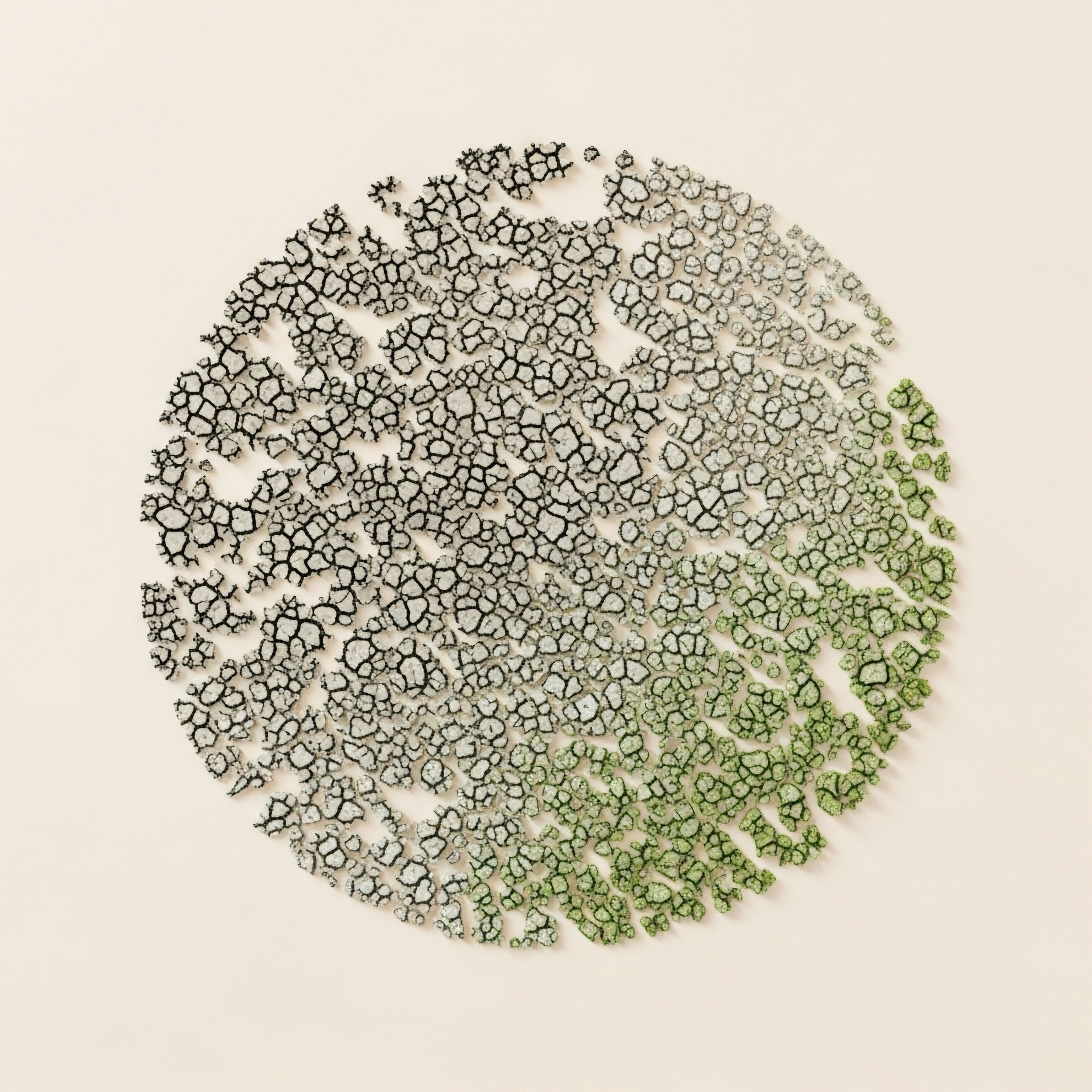

Fundamentals
The feeling often begins subtly. It is a sense that the body’s internal rhythm has shifted. Workouts that once left you energized now require days of recuperation. Mental clarity feels just out of reach, and the deep, restorative sleep you once took for granted seems to have been replaced by a state of persistent, low-level fatigue.
This experience, a gradual erosion of vitality, is a deeply personal and often isolating one. It is the body communicating a change in its internal operating system, a system governed by the silent, powerful language of hormones. Understanding this language is the first step toward reclaiming your biological sovereignty.
Your body operates via a sophisticated communication network known as the endocrine system. This network uses chemical messengers called hormones to transmit instructions between cells and organs, regulating everything from your metabolic rate and immune response to your mood and sleep cycles.
These hormones are produced by a series of glands, and their coordinated action is what creates the seamless experience of health and well-being. The entire structure functions as a finely tuned orchestra, where each instrument must play its part with precise timing and volume for the symphony of health to be harmonious.
The endocrine system is the body’s primary regulatory network, using hormones to manage physiological processes from energy use to cellular repair.

The Command and Control Center
At the apex of this hormonal hierarchy sits a critical structure in your brain ∞ the hypothalamic-pituitary (HP) axis. The hypothalamus acts as the master controller, constantly monitoring your body’s internal and external environment. It assesses nutrient levels, stress signals, light exposure, and countless other data points.
Based on this information, it sends precise instructions to the pituitary gland, its second-in-command. The pituitary then relays these orders to the downstream glands ∞ the thyroid, the adrenal glands, and the gonads (testes in men, ovaries in women). This top-down communication cascade ensures that your body’s resources are allocated appropriately to meet current demands.
For instance, the Hypothalamic-Pituitary-Gonadal (HPG) axis governs reproductive function and the production of sex hormones like testosterone and estrogen. The hypothalamus releases Gonadotropin-Releasing Hormone (GnRH) in pulses, signaling the pituitary to produce Luteinizing Hormone (LH) and Follicle-Stimulating Hormone (FSH).
These hormones, in turn, travel through the bloodstream to the gonads, instructing them to produce the hormones that define many aspects of male and female physiology, including muscle mass, bone density, libido, and cognitive function. This is a delicate feedback loop; the brain speaks to the glands, and the hormones produced by those glands speak back to the brain, creating a continuous, dynamic conversation.

When Communication Falters
With age, and often accelerated by chronic stress, poor nutrition, or environmental factors, the clarity of this internal communication can degrade. The hypothalamus may become less sensitive in its monitoring, the pituitary’s signals may weaken, or the glands themselves may become less responsive to the instructions they receive.
The result is a decline in the production of key hormones. This is a biological reality, a predictable consequence of the aging process. The subjective experience of this decline is what you feel as slowed recovery, brain fog, or a loss of drive.
Your body is still trying to perform, but its internal messaging service has become less efficient. The signals are no longer as strong or as clear as they once were, leading to a system-wide decrease in functional capacity. Understanding this allows you to see your symptoms through a new lens, one of biological mechanism rather than personal failing.


Intermediate
Lifestyle modifications including nutrition, exercise, and sleep hygiene are the bedrock of sustainable health and optimized recovery. They create the necessary environment for your body to repair and thrive. When these foundational elements are in place, certain clinical protocols can work in concert with them, acting as powerful catalysts to accelerate the restoration of function.
These interventions are designed to directly address the communication breakdowns within the endocrine system, re-establishing the hormonal signals that govern cellular repair, energy metabolism, and overall vitality. They provide the specific biochemical tools your body needs to expedite its own healing processes.
Targeted clinical protocols can amplify the benefits of a healthy lifestyle by directly restoring optimal hormonal signaling for accelerated recovery.

Hormonal Optimization for Systemic Recalibration
When baseline testing reveals a quantifiable decline in key hormones, and symptoms are affecting quality of life, protocols designed to restore these levels to a healthy physiological range can be considered. This approach is about biochemical recalibration, providing the body with the necessary molecules to bring its internal communication network back to full operational capacity.

Testosterone Replacement Therapy for Men
For men experiencing the symptoms of low testosterone (hypogonadism), a comprehensive protocol aims to restore this vital hormone to optimal levels while maintaining balance within the broader endocrine system. A standard, medically supervised protocol involves several components working in synergy.
- Testosterone Cypionate ∞ This is a bioidentical form of testosterone delivered via intramuscular or subcutaneous injection. The objective is to provide a consistent and stable level of testosterone in the blood, aiming for the mid-to-upper end of the normal reference range for a healthy young adult. This directly addresses the deficiency, helping to improve muscle mass, bone density, cognitive function, and libido.
- Gonadorelin ∞ During testosterone therapy, the brain’s HPG axis may reduce its own signaling because it detects sufficient external testosterone. Gonadorelin, a synthetic form of GnRH, is used to directly stimulate the pituitary gland. This preserves testicular function and helps maintain the body’s innate capacity for hormone production. It is typically administered via subcutaneous injection twice a week.
- Anastrozole ∞ Testosterone can be converted into estrogen through a process called aromatization. While some estrogen is necessary for male health, excessive levels can lead to unwanted side effects. Anastrozole is an aromatase inhibitor, an oral medication used in small doses to manage estrogen levels, ensuring the hormonal ratio remains in a healthy, balanced state.

Hormonal Support for Women
A woman’s hormonal journey involves complex fluctuations, particularly during the perimenopausal and postmenopausal transitions. Protocols are highly personalized, designed to alleviate symptoms and support long-term health. The focus is on restoring balance and function with carefully dosed therapies.
Low-dose testosterone therapy is increasingly recognized for its benefits in women, particularly for improving libido, energy levels, mood, and cognitive clarity. It is typically administered via weekly subcutaneous injections of Testosterone Cypionate at a fraction of the male dose.
Progesterone, another key hormone, is often prescribed to support sleep quality, mood stability, and to protect the uterine lining in women who still have a uterus. The approach is always tailored to the individual’s specific symptoms and lab results, acknowledging the unique biochemistry of female health.

Peptide Therapies for Targeted Recovery
Peptides are short chains of amino acids that act as precise signaling molecules in the body. They represent a more targeted approach to wellness, designed to activate specific biological pathways involved in repair and regeneration. They do not replace hormones; they stimulate the body’s own glands to optimize their function.
| Peptide Protocol | Primary Mechanism | Intended Therapeutic Effects |
|---|---|---|
| Ipamorelin / CJC-1295 | Stimulates the pituitary gland to release natural growth hormone in a pulsatile manner, mimicking the body’s own rhythm. | Improves sleep quality, accelerates tissue repair, supports fat loss, and enhances lean muscle mass. |
| Sermorelin | A growth hormone-releasing hormone (GHRH) analog that also encourages natural, pulsatile GH release from the pituitary. | Enhances recovery from exercise, improves body composition, and supports overall cellular health. |
| BPC-157 | A peptide derived from a stomach protein that promotes healing through angiogenesis (new blood vessel formation) and fibroblast activity. | Accelerates healing of muscle, tendon, and ligament injuries; reduces inflammation. |
| PT-141 | Activates melanocortin receptors in the central nervous system to influence sexual arousal and function. | Addresses low libido and sexual dysfunction in both men and women. |
These peptide protocols are typically administered via small, subcutaneous injections. For example, a common protocol for growth hormone optimization involves a nightly injection of an Ipamorelin/CJC-1295 blend. This timing capitalizes on the body’s natural spike in growth hormone release during deep sleep, thereby amplifying the restorative processes that occur overnight. BPC-157, often used for acute injuries, can be administered systemically or targeted near the site of injury to localize its healing effects.


Academic
The acceleration of physiological recovery through clinical intervention is predicated on the targeted manipulation of specific cellular and molecular pathways. While lifestyle factors establish the permissive metabolic and inflammatory environment for healing, advanced protocols introduce precise signaling molecules to direct and amplify the body’s endogenous repair mechanisms.
An academic examination of these protocols requires a deep investigation into the molecular biology of tissue regeneration, focusing on the interplay between hormonal signals, growth factors, and the cellular machinery responsible for rebuilding damaged tissue. The efficacy of these interventions is rooted in their ability to recapitulate and enhance the signaling cascades that govern growth and repair.

The Molecular Basis of Peptide-Mediated Tissue Repair
Peptide therapies represent a sophisticated evolution in regenerative medicine. Their mechanism of action is highly specific, targeting cellular receptors to initiate downstream signaling events that culminate in accelerated healing. The pentadecapeptide BPC-157 and growth hormone secretagogues (GHS) like the Ipamorelin/CJC-1295 combination provide excellent models for understanding these processes at a granular level.

Angiogenesis and Cellular Proliferation via BPC-157
Body Protection Compound-157 (BPC-157) is a synthetic peptide whose therapeutic potential appears to be mediated primarily through its profound pro-angiogenic effects. Tissue repair is metabolically demanding and is rate-limited by the availability of oxygen and nutrients, which are delivered by the vascular network.
BPC-157 has been shown in preclinical models to significantly upregulate the expression of Vascular Endothelial Growth Factor Receptor 2 (VEGFR2). The activation of the VEGFR2-Akt-eNOS signaling pathway is a central event in this process. This cascade promotes the survival, proliferation, and migration of endothelial cells, which are the building blocks of new blood vessels. By accelerating neovascularization at the site of injury, BPC-157 ensures that the damaged tissue receives the robust blood supply required for efficient repair.
Furthermore, BPC-157 appears to directly influence the behavior of fibroblasts, the cells responsible for synthesizing the collagen matrix that forms the scaffold of new tissue. Research suggests it modulates the FAK-paxillin pathway, which is integral to cell adhesion and migration, effectively mobilizing these critical repair cells to the site of injury.
This dual action of promoting blood vessel growth and stimulating fibroblast activity creates a powerful synergistic effect that speeds the resolution of damage in tissues ranging from muscle and tendon to ligament. While the majority of this research is based on animal models, the consistency of the findings points to a potent and fundamental mechanism of action.
Advanced clinical protocols leverage precise signaling molecules to activate endogenous repair cascades, accelerating recovery at the cellular level.

What Is the Role of Pulsatile Growth Hormone Secretion?
Growth hormone secretagogues (GHS) such as Sermorelin or the combination of Ipamorelin and CJC-1295 operate on a different but complementary axis. They interact with the GHRH receptor and the ghrelin receptor (GHSR) in the pituitary gland, respectively. Their combined action triggers a strong, pulsatile release of endogenous growth hormone (GH) that mimics the natural secretory patterns of a youthful individual. This pulsatility is of immense biological importance.
A large pulse of GH initiates a cascade of downstream events. The primary effect is the stimulation of Insulin-Like Growth Factor 1 (IGF-1) production, mainly in the liver. IGF-1 is a potent anabolic agent that promotes cell growth and proliferation in nearly every cell in the body.
It enhances protein synthesis and amino acid uptake into skeletal muscle, directly contributing to the repair of micro-tears induced by exercise. It also promotes the proliferation of satellite cells, the stem cells of muscle tissue, which are essential for muscle regeneration and hypertrophy. By amplifying these natural anabolic signals, GHS protocols directly accelerate the rebuilding process after physical stress.
| Parameter | BPC-157 | Growth Hormone Secretagogues (e.g. Ipamorelin/CJC-1295) |
|---|---|---|
| Primary Target | Endothelial cells, Fibroblasts | Somatotroph cells of the anterior pituitary |
| Core Mechanism | Upregulation of VEGFR2 pathway, leading to angiogenesis | Stimulation of GHRH-R and GHSR to induce pulsatile GH release |
| Key Downstream Mediator | Vascular Endothelial Growth Factor (VEGF) | Insulin-Like Growth Factor 1 (IGF-1) |
| Primary Therapeutic Action | Localized tissue repair and inflammation modulation | Systemic anabolic signaling and cellular regeneration |
| Clinical Application Focus | Acute soft tissue injuries (tendon, muscle, ligament) | Systemic recovery, sleep optimization, body composition improvement |

How Does This Affect the Hypothalamic Pituitary Gonadal Axis?
The integration of these protocols with foundational therapies like TRT requires a systems-biology perspective. The endocrine system is an interconnected web of feedback loops. For example, while TRT directly restores testosterone levels, the use of Gonadorelin ensures the HPG axis remains responsive.
This prevents the testicular atrophy that can occur with testosterone monotherapy and preserves the intricate signaling pathways between the brain and the gonads. The addition of an aromatase inhibitor like Anastrozole further refines the system, ensuring that the hormonal milieu is not just restored, but balanced.
This comprehensive approach, grounded in the principles of endocrinology, acknowledges that restoring one part of the system requires supporting the whole. The ultimate goal is the creation of a physiological environment where the body’s own powerful regenerative capacities can function without impediment.
When you layer targeted peptide therapies on top of this hormonal foundation, you are creating a multi-pronged strategy for accelerated recovery. You are providing the master anabolic hormones, optimizing the delivery of nutrients via enhanced blood flow, and stimulating the very cellular machinery responsible for turning those raw materials into functional tissue. This is how lifestyle changes are augmented by clinical protocols to produce a recovery timeline that would otherwise be biologically unattainable.

References
- Bhasin, Shalender, et al. “Testosterone Therapy in Men With Hypogonadism ∞ An Endocrine Society Clinical Practice Guideline.” The Journal of Clinical Endocrinology & Metabolism, vol. 103, no. 5, 2018, pp. 1715 ∞ 1744.
- Sehic, Amer, et al. “BPC-157 and Muscle/Tissue Healing ∞ A Narrative Review (2019 ∞ 2024).” ResearchGate, 2024.
- Jayasena, Channa N. and Richard Quinton. “Male Hypogonadism and Testosterone Replacement.” The Endocrinologist, issue 143, 2022, Society for Endocrinology.
- Chang, Chung-Hsun, et al. “The promoting effect of pentadecapeptide BPC 157 on tendon healing involves tendon outgrowth, cell survival, and cell migration.” Journal of applied physiology, vol. 110, no. 3, 2011, pp. 774-80.
- Sikirić, Predrag, et al. “Brain-gut axis and pentadecapeptide BPC 157 ∞ theoretical and practical implications.” Current Neuropharmacology, vol. 14, no. 8, 2016, pp. 857-865.

Reflection

What Does Full Recovery Mean to You?
You have now seen the biological blueprints for recovery, from the systemic hormonal conversations that set the stage for healing to the specific molecular signals that direct the work of individual cells. This knowledge provides a powerful framework for understanding the physical sensations you experience every day. It transforms the abstract feeling of fatigue into a concrete question about cellular energy production and the frustration of a healing plateau into a clear inquiry about vascular supply and growth factor signaling.
The information presented here is a map. It shows the terrain of your own internal biology and illuminates the pathways that lead toward optimized function. The next step of the process involves locating yourself on that map.
It requires an honest assessment of your own lived experience, a deep curiosity about your personal biochemistry, and a willingness to see your health as a dynamic system that you can actively influence. The journey to reclaiming your vitality begins with this fundamental shift in perspective, from being a passenger in your own body to becoming its informed and engaged pilot.

Glossary

endocrine system

pituitary gland

clinical protocols

gonadorelin

anastrozole

precise signaling molecules

growth hormone

ipamorelin

growth hormone secretagogues

cjc-1295

tissue repair

bpc-157

vascular endothelial growth factor




